






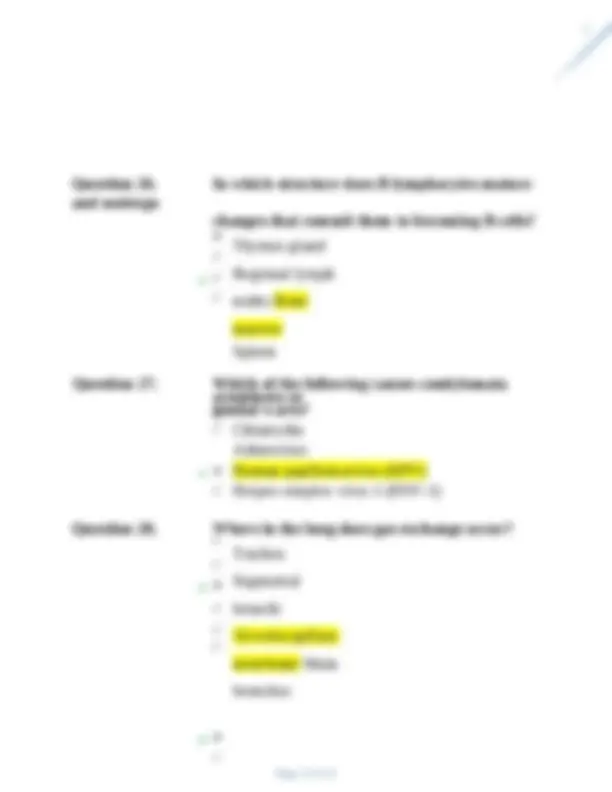








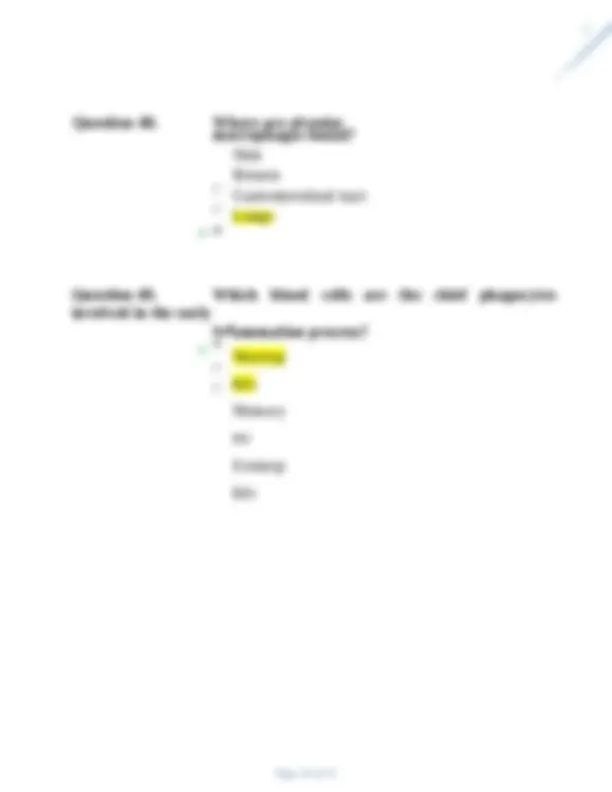


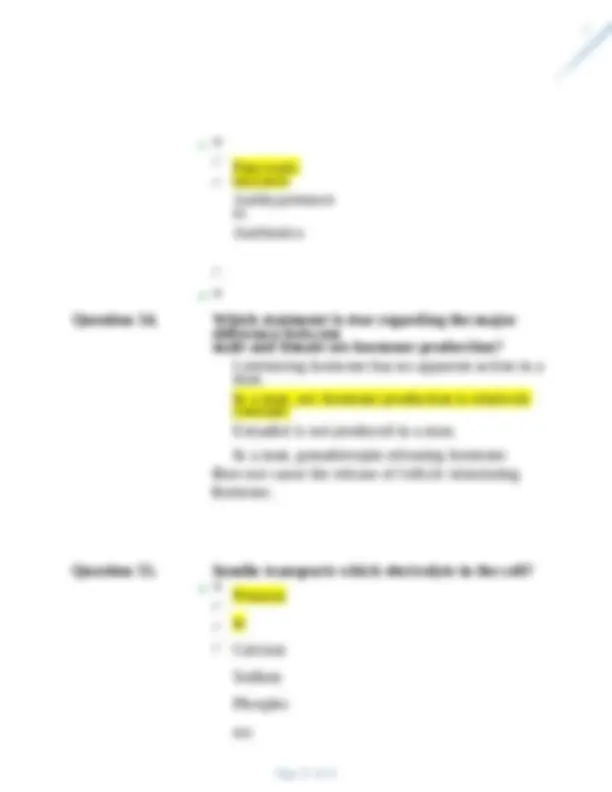


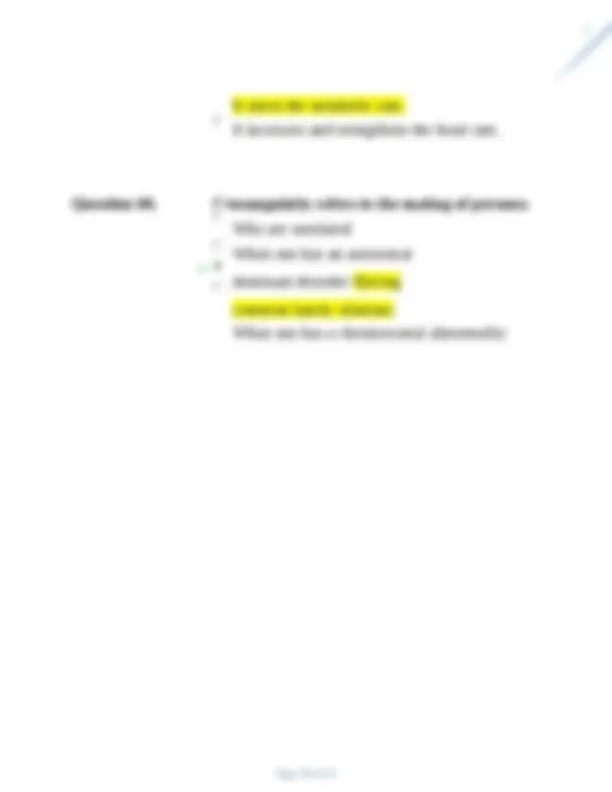
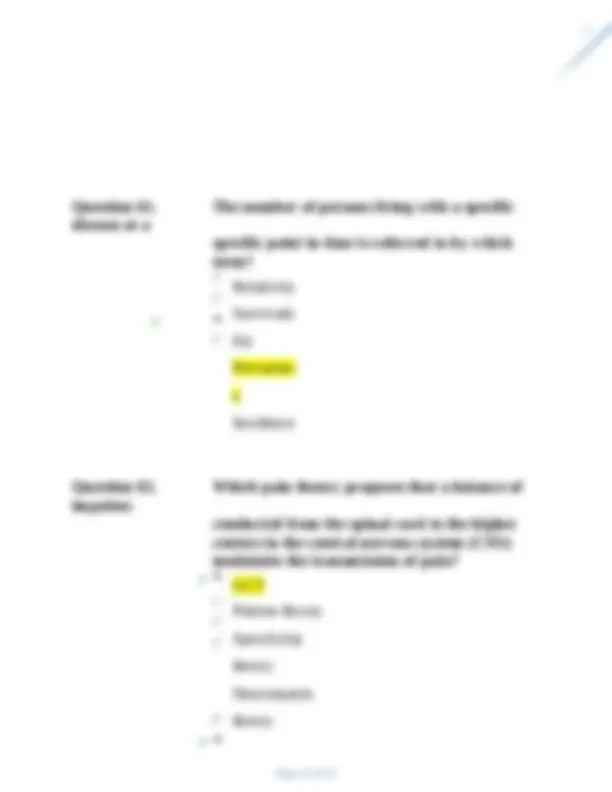
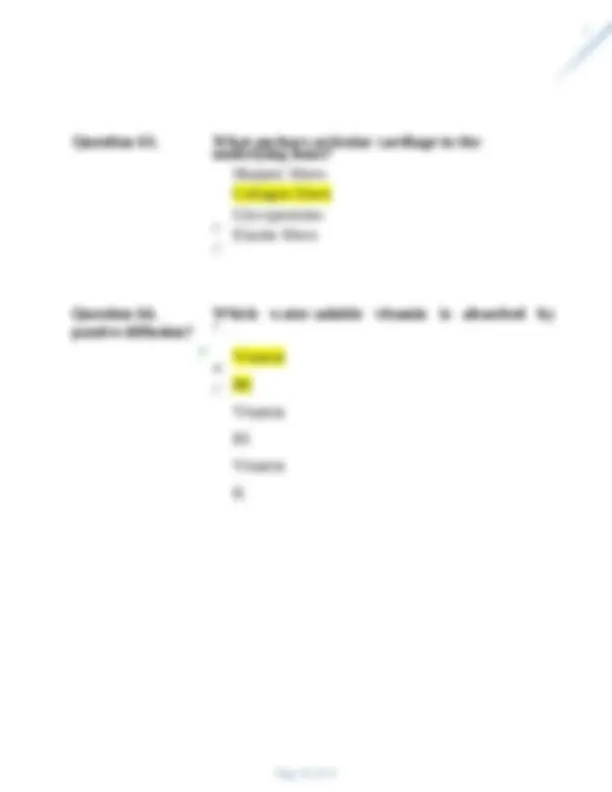
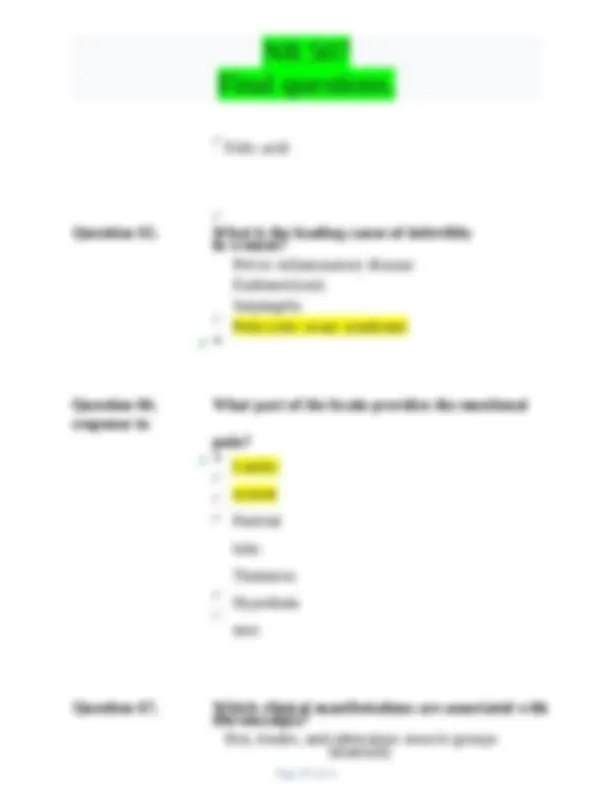



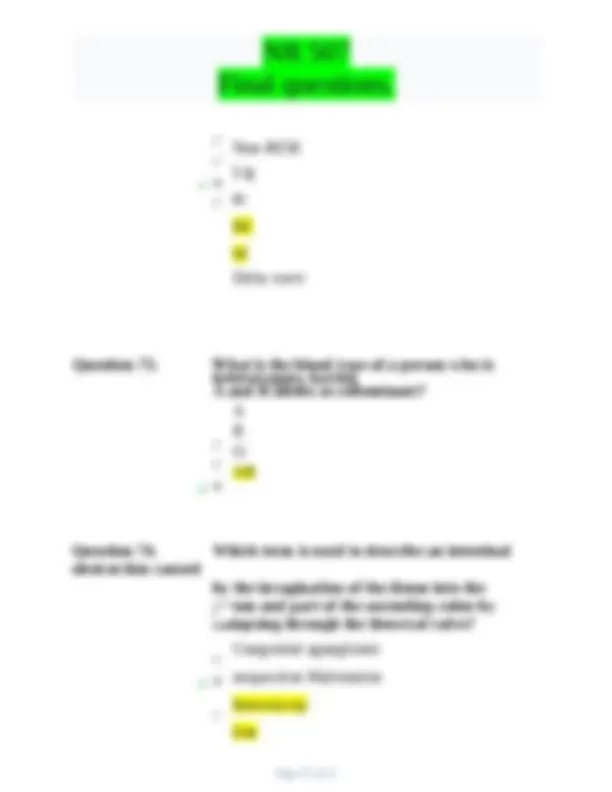

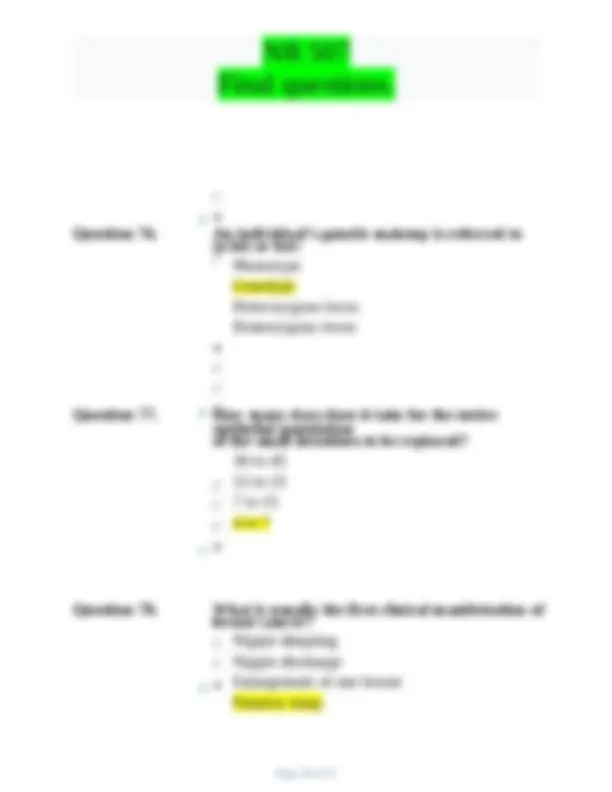

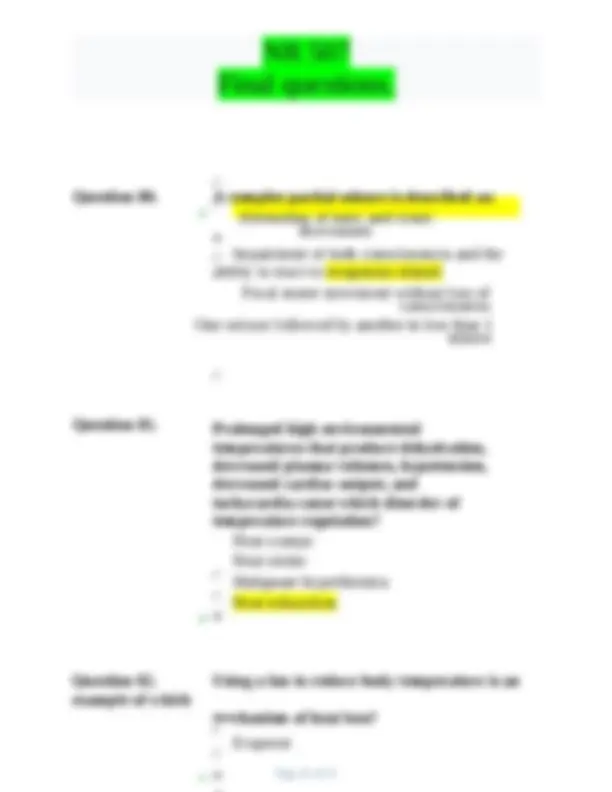

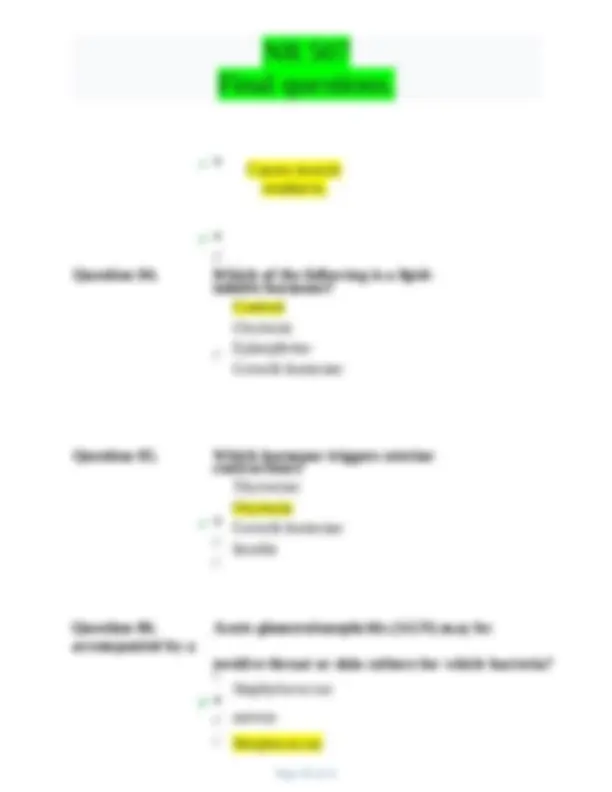





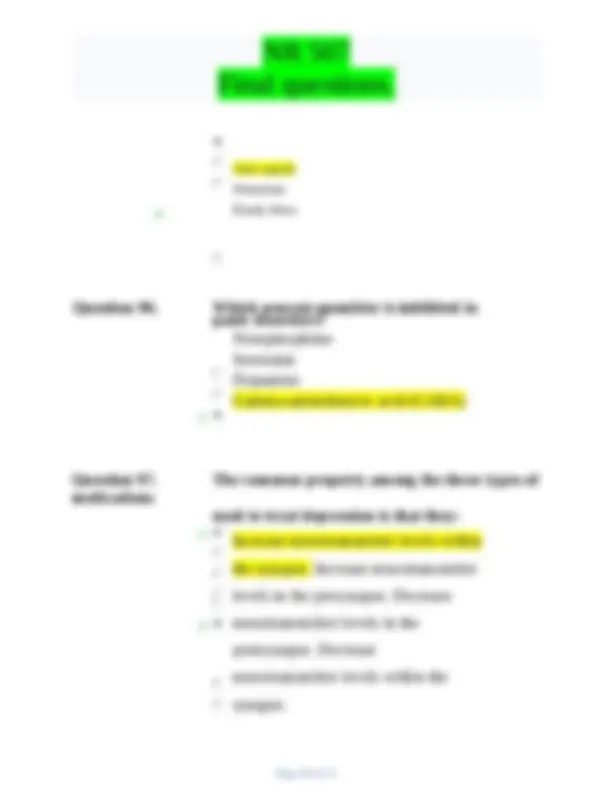




Study with the several resources on Docsity

Earn points by helping other students or get them with a premium plan


Prepare for your exams
Study with the several resources on Docsity

Earn points to download
Earn points by helping other students or get them with a premium plan
Community
Ask the community for help and clear up your study doubts
Discover the best universities in your country according to Docsity users
Free resources
Download our free guides on studying techniques, anxiety management strategies, and thesis advice from Docsity tutors
70 multiple-choice questions with correct answers related to various topics in healthcare such as anatomy, physiology, immunology, and infectious diseases. The questions cover a wide range of topics including the development of syphilis, kidney stones, abnormal cell proliferation, immunoglobulins, and cardiac potential. useful for students preparing for exams in healthcare-related courses.
Typology: Exams
1 / 51

This page cannot be seen from the preview
Don't miss anything!












































Question 1 : Which organism is responsible for the
development of syphilis?
Neisseria syphilis
Treponema pallidum
Haemophilus ducreyi
Chlamydia trachomatis
Question 2. : Kidney stones in the upper part of the ureter
would produce
pain referred to which anatomical area?
Vulva or penis
Umbili
cus
Thighs
Lower abdomen
Question 3.: Carcinoma refers to abnormal cell proliferation
originating
from which tissue origin?
Blood
vessels
Epithelial
cells
Connective
tissue
Glandular
tissue
Question 4. Which immunoglobulin is present in blood,
saliva, breast milk,
and respiratory secretions?
IgA
IgE
IgG
IgM
Question 5. What period follows depolarization of the
myocardium and
represents a period during which no new
cardiac potential can be propagated?
Refractory
Hyperpolariz
ation
Threshold
hormone (TSH)- receptor sites
Exposure to acetylates in substances
such as rubber
Question 9. Which statement is true regarding
pain and cancer?
Pain is primarily a result of pressure caused
by the tumor.
Pain indicates the metastasis of a cancer.
Pain is usually the initial symptom of
cancer.
Pain is generally associated with late-stage
cancer.
Question 10. Continued therapy of pernicious anemia (PA)
generally lasts
how long?
6 to 8 weeks
8 to 12 months
Until the iron level is
normal
The rest of one’s life
Question 11. Which of the following are formed elements of the
blood that
are not cells but are disk-shaped
cytoplasmic fragments essential for blood
clotting?
Monocyte
s Platelets
Macropha
ges
Erythrocy
tes
Question 12.Question : The ability of the pathogen to invade and
multiply in the host is
referred to
The virus is a soluble
antigen.
Question 14. Which normal physiologic change occurs
in the aging
pulmonary system?
Decreased flow resistance
Fewer alveoli
Stiffening of the chest wall
Improved elastic recoil
Question 15.Question : Which type of microorganism reproduces on
the skin?
Viruses
Bacteria and fungi
Protozoa and
Rickettsiae
Mycoplasma
Question 16. The common hay fever allergy is expressed
through a reaction
that is mediated by which class of
immunoglobulins?
IgE
IgG
IgM
T cells
Question 17. Obesity creates a greater risk for dehydration in
people
because:
Adipose cells contain little water because fat is
water repelling.
The metabolic rate of obese adults is slower than the
rate of
Question 21. At birth, which statement is true****?
Systemic resistance and pulmonary
resistance fall. Gas exchange shifts
from the placenta to the lung.
Systemic resistance falls and pulmonary
resistance rises.
Systemic resistance and pulmonary resistance
rise.
Question 22. On average, what percent of cardiac output
do the kidneys
receive?
10% to 20%
15% to 20%
20% to 25%
30% to 35%
Question 23. How is the effectiveness of vitamin B 12
therapy
measured?
Reticulocyte
count Serum
transferring
Hemoglobin
Serum
vitamin B 12
Question 24. What characteristic do atopic individuals have
that make them
genetically predisposed to develop allergies?
Greater quantities of histamine
More histamine receptors
Question 26. In which structure does B lymphocytes mature
and undergo
changes that commit them to becoming B cells?
Thymus gland
Regional lymph
nodes Bone
marrow
Spleen
Question 27. Which of the following causes condylomata
acuminata or
genital warts?
Chlamydia
Adenovirus
Human papillomavirus (HPV)
Herpes simplex virus 1 (HSV-1)
Question 28. Where in the lung does gas exchange occur?
Trachea
Segmental
bronchi
Alveolocapillary
membrane Main
bronchus
Question 29. The concentration of the final urine is
determined by
antidiuretic hormone (ADH), which is secreted
by which gland?
Posterior pituitary
Thyroid
Parathyroid
Anterior pituitary
Question 30. Exhaustion occurs if stress continues when
which stage of the
general adaptation syndrome is not successful?
papillomavirus
Pelvic inflammatory
disease
Question 33. What is the most common predisposing factor to
obstructive
sleep apnea in children?
Chronic respiratory
infections
Adenotonsillar
hypertrophy
Obligatory mouth
breathing Paradoxic
breathing
Question 34. What is the most commonly reported
symptom of cancer
treatment?
Nausea
Fatigue
Hair loss
Weight loss
Question 35. Blood cells that differentiate into macrophages
are known as:
Monocytes
Neutrophils
Eosinophils
Basophils
Question 36. Where are Langerhans cells
found?
Skin
Intestinal lining
Kidney
Thyroid
Question 37. Which glycoprotein protects against urolithiasis
Question 38. How does chest wall compliance in an infant
differ from that of
an adult?
An adult’s chest wall compliance is lower than an
infant’s.
An adult’s chest wall compliance is higher than an
infant’s.
An adult’s chest wall compliance is the same as an
infant’s.
An adult’s chest wall compliance is
dissimilar to that of an infant’s.
Question 39. Which renal change is found in
older adults?
Sharp decline in glomerular
filtration rate
Sharp decline in renal blood flow
Decrease in the number of
nephrons
Decrease in urine output
Question 40. Which nutritional deficiency in a pregnant
woman is associated
with neural tube defect (NTD)?
Iron
Vitamin C
Zinc
Folate
Question 41. Which sexually transmitted infection frequently
coexists with
gonorrhea?
Syphilis
Herpes simplex
virus
Chlamydia
Chancroid